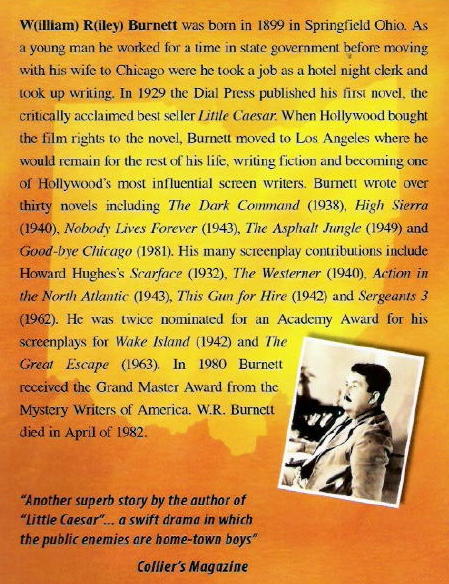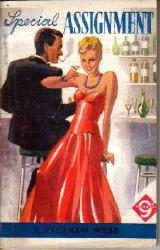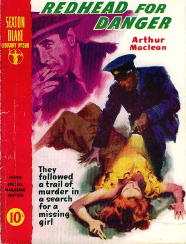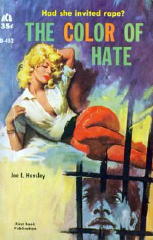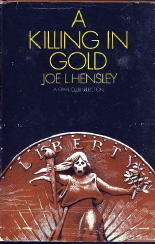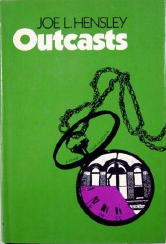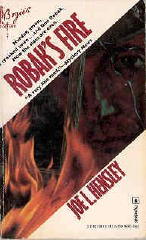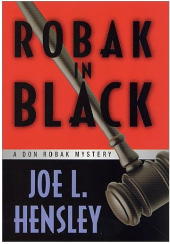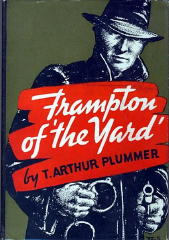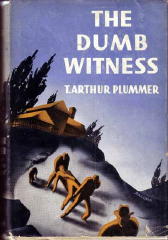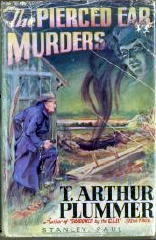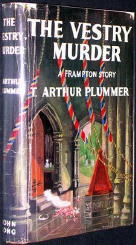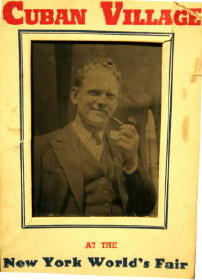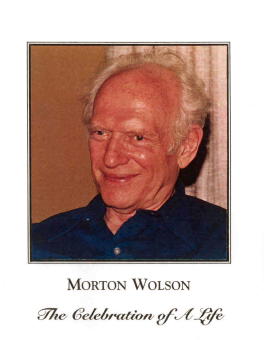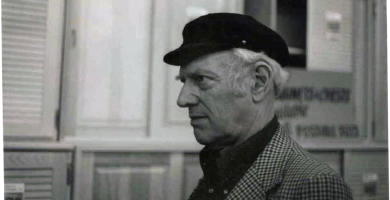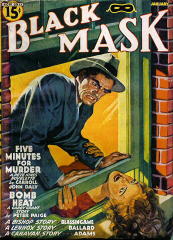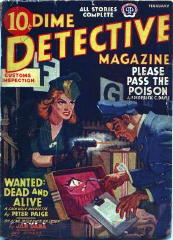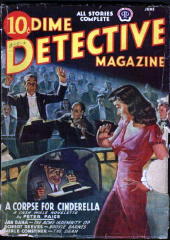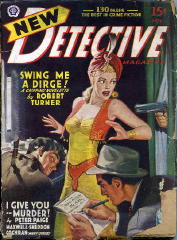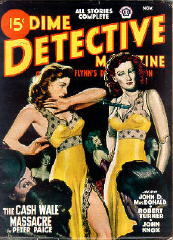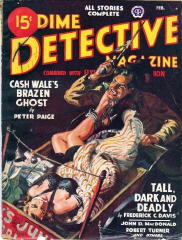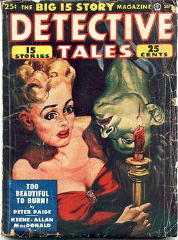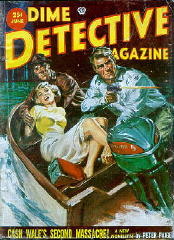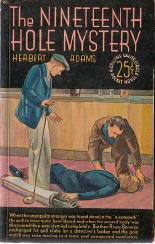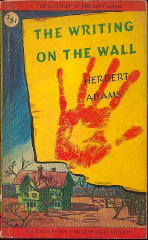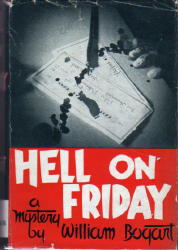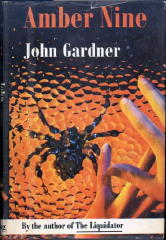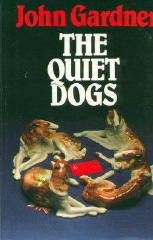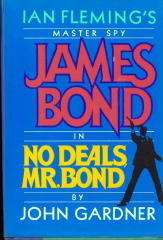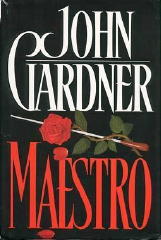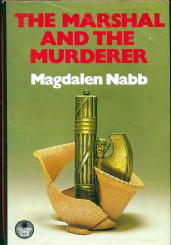August 2007
Monthly Archive
Fri 31 Aug 2007
Steve: About a year or so ago you were kind enough to post an article on O’Bryan House Publishers’ first title, Detour, by Martin M. Goldsmith. By agreement with the estate of W.R. Burnett, we are now issuing our second crime novel, Burnett’s Dr. Socrates. The details are listed below.
Best wishes and please let me know if you have any questions.
FIRST BOOK APPEARANCE OF W.R. BURNETT’S DR. SOCRATES
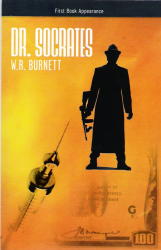
O’Bryan House Publishers, LLC is pleased to announce the first book appearance of W. R. Burnett’s hard boiled Depression Era novel, Dr. Socrates. Originally serialized in Collier’s Magazine in the spring of 1935, this is the story of young Dr. Cardwell who, after being forced at gun point to treat a wounded gangster, finds himself caught between the threat posed by gang leader Red Bastian and the suspicion of Federal Agents investigating a wave of bank robberies. Portions of the story line suggested by the saga of Public Enemy John Dillinger. First edition, first printing. The novel which served as the basis for the 1935 film Dr. Socrates starring Paul Muni, and Ann Dvorak and later the 1939 Humphrey Bogart film King of the Underworld.
W. R. Burnett is the author of Little Caesar, High Sierra and The Asphalt Jungle. He was nominated for two Academy Awards for best screenplay for Wake Island (1942) and The Great Escape (1963). In 1980 Burnett received the Grand Master Award from the Mystery Writers of America. Book includes a brief afterword by the publisher entitled “Dr. Socrates and Hollywood.” Dr. Socrates is available at Amazon.com or may be ordered directly from O’Bryan House Publishers LLC at rdoody@ix.netcom.com
I’m not sure if the text on the back cover will show up, but since there’s more information there, including a photo of Burnett, I’ll give it a try. Here it is:
The dates the story was serialized in Collier’s Magazine, which I’ve discovered from Google, are from 16 March through 20 April, 1935. It’s about time it came out as one complete novel. Good luck on the book, Richard!
Fri 31 Aug 2007
As part of Al Hubin’s ongoing Addenda to the Revised Crime Fiction IV, I uploaded Part 18 just a few minutes ago this morning. I’ve not had a chance to add any of my usual enhancements, links, covers and other annotations, but this latest installment is online and ready for you to take a look at now.
There are no major corrections, discoveries or revisions this time around. Just a steady stream of newly learned data: birth and death dates, settings, movies based on books, and so on.
This is what Al does. For an ongoing example of what I do, check out the main page, which consists of the data in Part 3. As of last night, I’ve worked my way down to:
WHITHAM, G(RACE) I(SABELLE?). 1874?- . Add tentative middle name & year of birth. Author of three titles included in the (Revised) Crime Fiction IV, one marginal.
A few entries before her are the following:
WEBB, C. PACKHAM. Probably also wrote as T(homas) C(harles) Packham Webb, 1908-1973, q.v. Under this name, the author of one thriller novel included in the (Revised) Crime Fiction IV. See below.
Special Assignment. Fiction House, UK, pb, 1947.
WEBB, T(HOMAS) C(HARLES) P(ACKHAM). 1908-1973. Add probable other byline: C. Packham Webb, q.v. Under his own name, the author of one thriller novel included in the (Revised) Crime Fiction IV, plus one Sexton Blake novel ghostwritten under author George Paul Mann’s “Arthur Maclean” byline. Other pseudonym: Tony Angelo.
_The Man Who Killed Me. See Redhead for Danger.
Midnight Intruder. Hamilton, UK, pb, 1950.
Redhead for Danger [as by Arthur Maclean]. Amalgamated Press, UK, pb, 1958. SC: Sexton Blake. Revised by G. P. Mann and published as The Man Who Killed Me (Amalgamated Press, 1962).
Wed 29 Aug 2007
Making the rounds on various blogs and websites this evening is the news that mystery & SF writer Joe L. Hensley died on Monday, August 27, 2007, of complications from leukemia.
Excerpted from the Private Eye Writers of America (PWA) blog:
“A retired lawyer, prosecuting attorney, Indiana General Assembly Member, and former Circuit Court Judge, he wrote science fiction and crime fiction as Joe L. Hensley and Louis J. A. Adams. His first published novel was
The Color of Hate, published by Ace in 1960. He went on to publish 20 more novels and collections, over half of them in the Donald Robak series, plus approximately 100 short stories.
“His final novel, Snowbird’s Blood is scheduled for release by St. Martin’s Press in early 2008.”
Harlan Ellison describes the loss of his lifelong friend on Ed Gorman’s blog, followed by Ed’s own reactions.
With a small overlap with his science fiction, here below is a list of his crime-related fiction, expanded from Crime Fiction IV, by Allen J. Hubin.
His most frequently used series character is Donald Robak, a crusading defense attorney and state legislator who lives in Bington, Indiana.
HENSLEY, JOE L.; [i.e., Joseph Louis Hensley] (1926-2007); Attorney, judge and legislator in Indiana.
* The Color of Hate (Ace, 1960, pb) [Indiana] Revised version published as: Color Him Guilty. Walker, 1987.
* Deliver Us to Evil (Doubleday, 1971, hc) [Donald Robak; Indiana]
* Legislative Body (Doubleday, 1972, hc) [Donald Robak; Indiana]
* The Poison Summer (Doubleday, 1974, hc) [Indiana]
* Song of Corpus Juris (Doubleday, 1974, hc) [Donald Robak; Indiana]
* -The Black Roads (Laser, 1976, pb) [Future]
* Rivertown Risk (Doubleday, 1977, hc) [Indiana]
* A Killing in Gold (Doubleday, 1978, hc) [Donald Robak; Indiana] Gollancz, 1979.
* Minor Murders (Doubleday, 1979, hc) [Donald Robak; Indiana]
* Final Doors (Doubleday, 1981, hc) [Indiana] Story collection.
* Outcasts (Doubleday, 1981, hc) [Donald Robak; Indiana]
* Robak’s Cross (Doubleday, 1985, hc) [Donald Robak; Indiana]
* Robak’s Fire (Doubleday, 1986, hc) [Donald Robak; Indiana]
* _Color Him Guilty (Walker, 1987, hc) [Georgia] Revised version of The Color of Hate (Ace, 1960).
* Fort’s Law (Doubleday, 1987, hc) [Indiana] Hale, 1991.
* Robak’s Firm (Doubleday, 1987, hc) [Indiana] Story collection: Donald Robak in several.
* Robak’s Run (Doubleday, 1990, hc) [Donald Robak; Indiana]
* Grim City (St. Martin’s, 1994, hc) [Kentucky]
* Robak’s Witch (St. Martin’s, 1997, hc) [Donald Robak; Indiana]
* Loose Coins (with Guy M. Townsend) (St. Martin’s, 1998, hc) [Memphis, TN]
* Deadly Hunger and Other Tales (Five Star, 2001, hc) Story collection: Donald Robak in several.
* Robak in Black (St. Martin’s, 2001, hc) [Donald Robak; Indiana]
* Snowbird’s Walk (St. Martin’s, 2008, hc)
Wed 29 Aug 2007
This post has been prompted by an entry on another blog by Jess Nevins, author of the soon-to-be forthcoming The Encyclopedia of Pulp Heroes (MonkeyBrain Books, November 2008).
The subject of Jess’s posting is the fleeting and inevitable passing of literary fame, although we don’t have to like it, and his prime example is mystery writer T. Arthur Plummer. You should probably go read it. If you’re like me, you will read and agree with everything he has to say.
You may be saying, who’s T. Arthur Plummer? And that’s precisely the point. Let me quote Jess:
“Mr. Plummer wrote over seventy novels. Fifty of them were about his series character, Detective-Inspector Andrew Frampton of Scotland Yard’s Criminal Investigation Department. The first was
Shadowed by the C.I.D. (1932), the last was
Murder at Brownhill (1962). Fifty novels about the same character, over thirty years.
“A total of 57 copies of Mr. Plummer’s books exist in libraries in the US and UK. A Google search for the phrase “T. Arthur Plummer” comes up with 118 hits. (In comparison, “Godzilla bukkake” yields 415, and “Harry Stephen Keeler” gives 39,800.) […] A Google Image search for Mr. Plummer’s work gives only one image ….
“The man wrote seventy novels in his lifetime. Fifty of them about one character. […] The stores would have been full of [his] books. (Abebooks only lists 116 copies of Plummer’s novels for sale. Harry Stephen Keeler has 519.) […]
“All but a lucky few writers are doomed to oblivion. It’s up to us to prevent that from happening.”
Me again. I was thinking about this very same thing this afternoon while browsing through the mystery section of Borders. John Gardner, author of a long list of spy and espionage thrillers, including more James Bond novels than Ian Fleming wrote, died earlier this month. Not a single book of his was there to be found.
Ed McBain died last year. The famous, extremely popular author of the 87th Precinct books? If you’re reading this, you have to know who he is. He’s represented by six books at Borders. Not six different titles. Six books. By this time next year, there probably won’t be any.
The number of Plummer’s books on ABE has gone up since Jess looked. I found 130. It’s still a mere handful for an author who wrote seventy of them.
I also found more covers than Jess did, though, and assuming that you’d like to see them, here they are, mixed in with a list of all of Plummer’s detective and mystery fiction, adapted from Crime Fiction IV, by Allen J. Hubin:
PLUMMER, T(homas) ARTHUR. 1883-1961.
* The Broken Trust (n.) Thomson 1929 [England]
* The Ace of Death (n.) Paul 1930 [England]
* The Murder House (n.) Paul 1930 [England]
* Death on Danger Hill (n.) Paul 1931 [England]
* The House in Sinister Lane (n.) Paul 1931 [England]
* -The Girl in a Hurry (n.) Thomson 1932 [England]
* Haunting Lights (n.) Paul 1932 [England]
* Shadowed by the C.I.D. (n.) Paul 1932 [Det. Insp. Andrew Frampton; England]
* Alias-The Crimson Snake (n.) Paul 1933 [England]
* Lonely Hollow Mystery (n.) Paul 1933 [England]
* Creaking Gallows (n.) Paul 1934 [England]
* Death Takes a Hand (n.) Paul 1934 [England]
* -Margaret Benson’s View (n.) Leng 1934 [England]
* Shot at Night (n.) Paul 1934 [Det. Insp. Andrew Frampton; England]
* Frampton—of the “Yard”! (n.) Paul 1935 [Det. Insp. Andrew Frampton; England]
* Staring Eyes! (n.) Paul 1935 [England]
* The Dumb Witness (n.) Paul 1936 [Det. Insp. Andrew Frampton; England]
* Was the Mayor Murdered? (n.) Paul 1936 [Det. Insp. Andrew Frampton; England]
* The Bonfire Murder (n.) Macaulay 1937; See: Was the Mayor Murdered? (Paul, 1936).
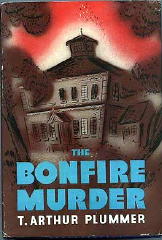
* The Death Symbol (n.) Paul 1937 [Det. Insp. Andrew Frampton; England]
* The Man They Feared (n.) Paul 1937 [Det. Insp. Andrew Frampton; England]
* Cornered (n.) Leng 1938 [England]
* Five Were Murdered (n.) Paul 1938 [Det. Insp. Andrew Frampton; England]
* -Lying Lips (n.) Leng 1938 [England]
* The Man They Put Away (n.) Paul 1938 [Det. Insp. Andrew Frampton; England]
* -Her Own Affair (n.) Leng 1939 [England]
* The Muse Theatre Murder (n.) Paul 1939 [Det. Insp. Andrew Frampton; England; Theatre]
* Two Men from the East (n.) Paul 1939 [Det. Insp. Andrew Frampton; England]
* The Black Ribbon Murders (n.) Paul 1940 [Det. Insp. Andrew Frampton; England]
* Melody of Death (n.) Paul 1940 [Det. Insp. Andrew Frampton; England]
* Crime at Crooked Gables (n.) Paul 1941 [Det. Insp. Andrew Frampton; England]
* The Devil’s Tea-Party (n.) Paul 1942 [Det. Insp. Andrew Frampton; England]
* The Fool of the “Yard” (n.) Paul 1942 [Det. Insp. Andrew Frampton; England]
* The Man Who Changed His Face (n.) Paul 1943 [Det. Insp. Andrew Frampton; England]
* Murder Limps By (n.) Paul 1943 [Det. Insp. Andrew Frampton; England]
* Murder-by an Idiot (n.) Paul 1944 [Det. Insp. Andrew Frampton; England]
* Simon Takes “the Rap” (n.) Paul 1944 [Det. Insp. Andrew Frampton; England]
* The “J for Jennie” Murders (n.) Paul 1945 [Det. Insp. Andrew Frampton; England]
* The Man with the Crooked Arm (n.) Paul 1945 [Det. Insp. Andrew Frampton; England]
* Murder in the Village (n.) Paul 1945 [Det. Insp. Andrew Frampton; England]
* The Strangler (n.) Paul 1945 [Det. Insp. Andrew Frampton; England]
* The Barush Mystery (n.) Paul 1946 [Det. Insp. Andrew Frampton; England]
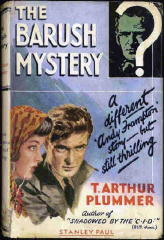
* The Pierced Ear Murders (n.) Paul 1947 [Det. Insp. Andrew Frampton; England]
* The Silent Four (n.) Paul 1947 [Det. Insp. Andrew Frampton; England]
* Who Fired the Factory? (n.) Paul 1947 [Det. Insp. Andrew Frampton; England]
* “Brent”-of Bleak House (n.) Paul 1948 [England]
* Hunted! (n.) Paul 1948 [Det. Insp. Andrew Frampton; England]
* Strychnine for One (n.) Paul 1949 [Det. Insp. Andrew Frampton; England]
* Death Haunts the Repertory (n.) Paul 1950 [Det. Insp. Andrew Frampton; Theatre; England]
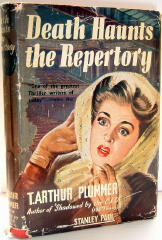
* The Murder of Doctor Grey (n.) Paul 1950 [Det. Insp. Andrew Frampton; England]
* The Yellow Disc Murders (n.) Paul 1950 [Det. Insp. Andrew Frampton; England]
* The Death Letter (n.) Paul 1951 [England]
* Murder at Marlington (n.) Paul 1951 [Det. Insp. Andrew Frampton; England]
* Murder Through Room 45 (n.) Paul 1952 [Det. Insp. Andrew Frampton; England]
* The Starry Eyed Murder (n.) Paul 1952 [England]
* Frampton Sees Red (n.) Paul 1953 [Det. Insp. Andrew Frampton; England]
* The Westlade Murders (n.) Paul 1953 [Det. Insp. Andrew Frampton; England]
* Murder in Windy Coppice (n.) Paul 1954 [Det. Insp. Andrew Frampton; England]
* A Scream at Midnight (n.) Paul 1954 [Det. Insp. Andrew Frampton; England]
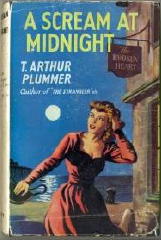
* The Black Rat (n.) Paul 1955 [Det. Insp. Andrew Frampton; England]
* Murder in the Surgery (n.) Paul 1955 [Det. Insp. Andrew Frampton; England]
* Pagan Joe (n.) Paul 1956 [Det. Insp. Andrew Frampton; England]
* Where Was Trail Murdered? (n.) Paul 1956 [Det. Insp. Andrew Frampton; England]
* Condemned to Live (n.) Paul 1957 [Det. Insp. Andrew Frampton; England]
* Murder at Lantern Corner (n.) Long 1957 [Det. Insp. Andrew Frampton; England]
* The Elusive Killer (n.) Long 1958 [Det. Insp. Andrew Frampton; England]
* The Hospital Thief (n.) Long 1959 [Det. Insp. Andrew Frampton; England]
* The Vestry Murder (n.) Long 1959 [Det. Insp. Andrew Frampton; England]
* The Spider Man (n.) Long 1961 [Det. Insp. Andrew Frampton; England]
* Murder at Brownhill (n.) Long 1962 [Det. Insp. Andrew Frampton; England]
* -The Judas Girl (n.) Leng n.d.
* -A Woman’s Weapon (n.) Newnes n.d.
[UPDATE] 08-30-07. Thanks to Jamie Sturgeon, who supplied it, one additional cover image is now included. He also pointed out one important typographical error, which was immediately repaired. Some other minor formatting changes have taken place, but more than that, you need not know.
[UPDATE] 09-06-07. Jamie is continuing to investigate the life of T. Arthur Plummer, and one interesting piece of information has already turned up. Its turns out that both Plummer’s wife and daughter were also writers. Steve Holland has the details over on his research-intensive Bear Alley blog.
Both women wrote British romantic fiction, a subject matter which has not come up before on this blog, except for gothic suspense novels, with dozens of books between them. His wife, Coralie Marie Plummer, wrote under the name of Cora Linda; his daughter, Clare Emsley Plummer, used as bylines both Clare Plummer and Clare Emsley. For a remarkably complete list of titles, follow the link above.
Sun 26 Aug 2007
Morton Wolson, 1913-2003, or Peter Paige, as he was known when he was writing for the detective pulps, has come up for discussion several times in these pages. The first time was a review I did of his only full-length novel, Nightmare Blonde (Pocket, 1988). In the course of the review I included everything I knew about the author at the time.
The second time came soon thereafter, when Morton’s son Peter spotted the review and sent me an email that provided quite a bit more information about him.
After reading both of these entries on the blog, pulp enthusiast and collector Walker Martin emailed me to tell the story of how he tracked down Morton Wolson in the 1980s and had a long afternoon’s conversation with him about his days in the pulps.
Peter has kept in touch with me in the weeks since, and he recently sent me a couple of photos of his father, which of course I’m very pleased to be able to show you here.
This first one was taken when he was a bouncer at the Cuban Village in the New York 1939 World’s Fair, as he looked when he wrote his first piece for Black Mask, “I Guard Nudes.”
Peter adds that this occurred shortly after he returned from fighting against Franco in the Spanish Civil war, in which he was a member of the Lincoln Brigade, had been appointed Chief Cadre officer, and then was a partisan fighter in the Basque country, blowing bridges and trains, as depicted in Hemingway’s For Whom the Bell Tolls.
This next one is the one used at his memorial services at the time of his death.
If you follow the links back to the previous entries, you’ll find that Morton’s stories under his own name have been discussed previously. This time around you’ll find a complete list of all of the pulp fiction that he wrote as Peter Paige, beginning with the previously mentioned “I Guard Nudes,” (Black Mask, Sept 1939) a story about security measures at a NY World’s Fair sideshow featuring scantily clad exotic dancers.
Paige’s primary series character was Cash Wale, a hardboiled New York City private eye in the Race Williams vein. His sidekick, Sailor Duffy, is an ex-pug with “scrambled brains” whom Wale watches out for. Lots of violent action, tough talk, and wisecracks, says Bill Pronzini, when I asked him what he recalled about the pair. Dime Detective was the primary venue for the Cash Wale series, but Wale’s very first appearance was in the January 1940 issue of Black Mask, the only time he showed up in that magazine.
The primary source of the data below is the two volume index Mystery, Detective, and Espionage Fiction, by Michael L. Cook and Stephen T. Miller. (Garland, 1988). Additional input came from Bill Pronzini, who provided much of the story information above and assistance when Cook-Miller produced questions I could not answer.
THE PETER PAIGE STORIES —
“I Guard Nudes,” Black Mask, September 1939.
Reprinted in Big Double Feature Magazine, 1#1, circa 1940 as “I Guard Dudes”
FOOTNOTE #1.
“Swastika Scorge,” Black Mask, December 1939.
“Voodoo Frame,” Black Mask, January 1940. CW = Cash Wale.
“The Fatherland of Otto Bloch,” Detective Fiction Weekly, Jan 27 1940.
“Blackout!” Black Mask, February 1940.
“Counterfeit Citizen,” Black Mask, March 1940.
“The Friends of Papa Valdes,” Black Mask, April 1940.
“The Corpse Promoter,” Detective Tales, April 1940.
“My Pop, the Cop,” Detective Fiction Weekly, Apr 27 1940.
“And God Won’t Tell,” Black Mask, July 1940.
“Pick’s Last Crime,” Detective Fiction Weekly, Aug 10 1940.
“Lotta Had a Husband,” Dime Detective, September 1940. CW.
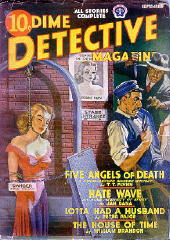
“Pick’s Last Crime,” Detective Fiction Weekly, Oct 26 1940. FOOTNOTE #2.
“Blitzkrieg Bankroll,” Fifth Column Stories, November, 1940.
“They Refuse to Understand,” Detective Fiction Weekly, Dec 7 1940.
“Dopey and theDevil,” Detective Fiction Weekley, Dec 21 1940.
“Treachery Goes to School,” Fifth Column Stories, January, 1941.
“Bomb Heat,” Black Mask, January 1941.
“Wanted: Dead and Alive” Dime Detective, February 1941. CW.
“The Bullet from Nowhere,” Dime Detective, April 1941. CW.
“Lady, Can You Spare a Corpse?” Dime Detective, June 1941. CW.
“Picture Me Dead!” Black Mask, November 1941.
“Local Corpse Makes Good,” Dime Detective, November 1941. CW.
“The Night You Shot Hitler,” Black Mask, February 1942.
“Death Is from Hunger,” Dime Detective, April 1942. CW.
“A Corpse for Cinderella,” Dime Detective, June, 1942. CW.
“Death Is a Souvenir,” Black Mask, August 1942.
“Berlin Papers, Please Copy,” Black Mask, September 1942.
“Joe Is Dead,” New Detective, January 1943.
“Death Stands By,” Dime Detective, February 1943. CW.
“Just a Sample,” Short Stories, May 1943.
“I Give You – Murder!” New Detective, November 1943.
“The Riddle of Papa Rio,” Dime Detective, August 1945. CW.
“Twelve Dead Mice,” Dime Detective, January 1946.
“Guilt-Edged Frame,” Dime Detective, September 1946.
“A Little Corpse Who Wasn’t There,” Dime Detective, December 1946. CW
“Cash in the Chips,” Dime Detective, January 1947. CW
“When a Man Murders,” Dime Detective, March 1947. CW
“Meet Me in Death Alley,” Detective Tales, May 1947. CW
“Death – on the House,” Dime Detective, June 1947. CW
“Softly Creep and Softly Kill!” Detective Tales, August 1947.
Reprinted in Triple Detective, Summer 1953
“The Cash Wale Massacre,” Dime Detective, November, 1947. CW
“The Merry Wives of Murder,” Detective Tales, February 1948.
“Cash Wale’s Brazen Ghost,” Dime Detective, February 1948. CW
“Die, Little Lady,” Detective Tales, March 1948.
“The Sweetest Corpse in Town!” Detective Tales, April 1948
Reprinted in Triple Detective, Fall 1953.
“House in Silence,” Dime Detective, June 1948.
“Too Beautiful to Burn,” Detective Tales, September 1948.
“Cash Wale’s Lethal Lulu,” Dime Detective, October 1948. CW
“The Corpse and I,” Dime Detective, January 1949.
“That Mad, Mean Murder Man,” Detective Tales, March 1949.
“Cash Wale’s Carnival Kill,” Dime Detective, May 1949. CW
“Coffin Cure,” Dime Detective, July 1949.
“Cash Wale’s Second Massacre!” Dime Detective, June 1953. CW
“Adam and Evil!” Detective Tales, August 1953.
“The Watcher” Manhunt, November 1953.
Stories as by MORTON WOLSON: [FOOTNOTE #3]
“The Attacker” Ellery Queen’s MM, January 1954.
“The Glass Room” Ellery Queen’s MM, September 1957.
Nightmare Blonde, novel, Pocket, 1988.
FOOTNOTE #1. Bill Pronzini and I suspect that the altered title is a slip of the finger on the part of Cook-Miller. The single issue of Big Double Feature Magazine consisted of nothing but reprint stories, the westerns from Ranch Romances, the mysteries from Black Mask.
FOOTNOTE #2. The title of this story is the same as that for the August 10, 1940, issue of Detective Fiction Weekly. Neither Bill nor I have either magazine, but one possibility that he suggests is that Paige’s “You’re the Jury” in the November 16, 1940 issue of DFW is listed as #3 in a series of true stories. It could be that “Pick’s Last Crime” was both #1 and #2, a two-parter despite the two-month gap or maybe a followup piece.
[UPDATE] 08-27-08. In the comment he left early this morning after checking his set of DFW, Walker Martin reports that, surprisingly enough, what the magazine did was to publish two separate stories by Paige having the very same title.
FOOTNOTE #3. The first version of this list included only the stories written by Morton Wolson as Peter Paige for the pulp magazines, and somehow the story he did for Manhunt, a digest, was missed. Thanks to Jiro Kimura for catching this. See his comment that follows. Having added the one missing story, I decided to include the three other stories he did under his own name. Compleatness is the goal, after all!
Sun 26 Aug 2007
One
online commentator describes Roger Bennion, the detective character created by Herbert Adams, thusly: “… amateur sleuth and son of a wealthy baronet. He is more amoral than is usual for the period, often willing to obstruct justice to help a pretty damsel in distress, but basically a decent and charming chap.”
A list of all of Roger Bennion’s appearances will follow Mary’s review of the very last case he solved.
The character’s creator, Herbert Adams, 1874-1958, is probably best remembered (and collected) for his golfing mysteries, eight of them in all. You can find them listed and commented upon here, for example.
As for Death of a Viewer, I apologize for the very limited image I’ve been able to find for the book. There seems to be only one copy available for sale on the Internet. The asking price is just under $500.
On the other hand, you may read it online for free.
HERBERT ADAMS – Death of a Viewer.
Macdonald, UK, hc, 1958.
Since it was published in the 1950s, Death of a Viewer hangs its toes over the precipice marking the end of the Golden Age period, but what the hay, the Roger Bennion series began in the 1930s so let’s agree this entry is grandfathered into my general area of discussion.

Captain Oswald Henshaw tells his lovely young wife Sandra their financial resources are gone — but suggests if he sees her in comprising circumstances with Ewen Jones, Member of Parliament for an East London constituency, there could well be financial benefits. Ewen’s father is Lord Bethesda and his stepmother is worth half a million. Naturally they’d want to keep scandal — such as Hensaw bringing an action for alienation of affection against Ewen — from breathing nastily on the family name.
Major Bennion becomes involved because Ewen lives in one of the houses built by Bennion Senior near the London docks. These homes are intended for disabled servicemen, old age pensioners, and the like and Bennion Senior wishes the better-off MP, who became a tenant due to a loophole, to move out so Lord Bethesda’s elderly gardener can retire and live there.
Ewen refuses but asks Bennion to visit the family home of Welton Priory “in that charming part of the country where Sussex joins Hampshire.” Several Labour MPs are meeting there that weekend to secretly discuss plans to make the party more Socialist. Bennion’s presence will suggest the gathering is the usual sort of house party — and while he’s there perhaps he’ll persuade Ewen’s father to buy him, Ewen, a house or give him an allowance! The Henshaws will also be attending as Ewen’s guests, and thus the wheels of the plot begin to turn.
Before too long there are interesting conversations overheard, furtive visits to bedrooms, and fiery political rhetoric that does not go down too well with the MPs. The viewer’s death occurs in a room full of people during a TV play about the Battle of Britain, and with very little to initially go on except a scrap of paper and a house full of suspects Bennion and Scotland Yard’s Superintendent Yeo and Inspector Allenby cooperate to solve the crime.
My verdict: Ewen gets on his soapbox and in doing so reminds readers of the unrest in the air in the 1950s, including calls for the abolition of hereditary titles, Church and union reform, disgust at the possibilities of easier divorce, and legalisation of what is quaintly described as the sin of Sodom and Gomorrah. These references will make the legendary Cheltenham colonels who so often write to the editor of The Times weep with joy, but alas they tend to swamp parts of the earlier part of the novel and do not add very much to the plot.
However, once we get to the actual detecting the story runs along nicely. More than one house guest has what they might see as good reason to act against the deceased, so most of them are suspected at one time or another and the solution roars up after an unexpected twist which certainly caught me by surprise. I reget to say however that on the whole this novel is not one of the best I have read.
Etext: http://gutenberg.net.au
THE ROGER BENNION NOVELS. Taken from Crime Fiction IV, by Allen J. Hubin. Quite surprisingly, although a few were reprinted in paperback in Canada, none of these were ever published in the US. As you will see, there is some overlap with Adams’ golfing mysteries, as indicated.
# Death Off the Fairway (n.) Collins 1936 (Golf)
# The Old Jew Mystery (n.) Collins 1936
# A Single Hair (n.) Collins 1937
# Black Death (n.) Collins 1938
# The Bluff! (n.) Collins 1938
# The Damned Spot (n.) Collins 1938
# The Nineteenth Hole Mystery (n.) Collins 1939 (Golf)
# The Case of the Stolen Bridegroom (n.) Collins 1940
# The Chief Witness (n.) Collins 1940
# Roger Bennion’s Double (n.) Collins 1941
# Stab in the Back (n.) Collins 1941
# The Araway Oath (n.) Collins 1942
# Signal for Invasion (n.) Collins 1942
# Victory Song (n.) Collins 1943
# Four Winds (n.) Collins 1944
# The Writing on the Wall (n.) Collins 1945
# Welcome Home! (n.) Macdonald 1946
# Diamonds Are Trumps (n.) Macdonald 1947
# Crime Wave at Little Cornford (n.) Macdonald 1948
# One to Play (n.) Macdonald 1949 (Golf)
# The Dean’s Daughters (n.) Macdonald 1950
# The Sleeping Draught (n.) Macdonald 1951
# Exit the Skeleton (n.) Macdonald 1952
# The Spectre in Brown (n.) Macdonald 1953
# Slippery Dick (n.) Macdonald 1954
# The Judas Kiss (n.) Macdonald 1955
# Death on the First Tee (n.) Macdonald 1957 (Golf)
# Death of a Viewer (n.) Macdonald 1958
Sat 25 Aug 2007
Here’s both a private eye and a private eye author you’re not too likely to have heard of before. Sam Carroll is the PI, and Robert Leigh is the author. Both of two books were published in England, one of them was published here in the US, and neither of them ever appeared in paperback. Once upon a time private eye novels were always published in paperback, and often paperback only. Not any more.
Here, before going to the books themselves, is the author’s entry in Crime Fiction IV, by Allen J. Hubin:
LEIGH, ROBERT (1933- )
* The Cheap Dream (London: Macmillan, 1982, hc) [Sam Carroll; London] U.S. title (?): First and Last Murder. St. Martin’s, 1983.
* _First and Last Murder (St. Martin’s, 1983, hc) See: The Cheap Dream (Macmillan (London) 1982).
* The Girl with the Bright Head (London: Macmillan, 1982, hc) [Sam Carroll]
We can make some additions and correction to that entry right away. The US novel entitled First and Last Murder is not The Cheap Dream, as conjectured, but the The Girl with the Bright Head, which happens to be Leigh’s second novel. The setting is London, the same as the first one.
THE CHEAP DREAM
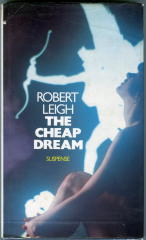
From the front inside DJ flap:
“I reached for a cigarette and then heard the rhythmic pocking of the record player. As I looked down at it I saw that the record was still spinning. The machine hadn’t been damaged in all the violence. There was blood on it and one drop had stayed in a groove. It spun around with the record like a rose in a whirlpool.”
Sam Carroll was good at finding out what really goes on behind the neon glitter of modern London. He aspires to the highest level of the ‘crusader’ private eye. His world is bounded by central London, and focussed on Soho. This is a London of the most depraved character, of sex in many forms, drugs, gambling, reckless and dissolute extravagance. It is peopled by pop stars, models, prostitutes, negroes, journalists, a fringe world of night-birds awash with money and frenetic for ‘happiness’ or release.
A man of wealth, a publisher of shady magazines, wants Carroll to investigate the circumstances of the death of a girl called Valentine: a drug addict, she appeared to have died from an overdose. But an ‘open verdict’ had been returned so there seemed to be something worth investigating.
As he wades through the expensive twilight of the city, Carroll runs into an assortment of other characters who don’t wish him well and soon finds himself on the floor in a Pimlico basement next to a small black corpse.
An exciting and weird story is told with clarity and elegance in this unusual first novel.
From the inside back DJ flap:
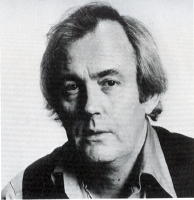
ROBERT LEIGH was born in 1933. His first job was as a junior reporter on the Kent Messenger and he subsequently worked in Paris (carrying sandwich boards for the Jean Cocteau cinema), in Soho and Victoria (selling ice cream, writing for literary magazines), in Holland (writing a column for a Dutch daily newspaper), in Spain (coaching a local village football team, writing articles for the New York Times) and is now back in London running an advertising consultancy.
He still plays a lot of sport from Sunday morning football to canoeing and badminton, and has plans for further Sam Carroll novels.
Review excerpts (from the back cover of The Girl with the Bright Head):
“A fresh talent stirs.” The Guardian.
“Does more than pass muster.” The Observer.
“Undoubted talent.” Catholic Herald.
“Augurs well for subsequent thrillers.” Manchester Evening News.
THE GIRL WITH THE BRIGHT HEAD
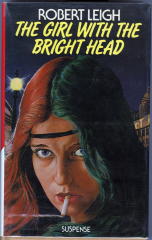
From the inside DJ flap:
In his first novel, The Cheap Dream, Robert Leigh introduced the private investigator Sam Carroll. Carroll belongs to the ‘crusader’ school of private eyes and his first recorded adventure took place amid the candy-floss glitter and deepest vice that stains a spectrum of society not far below the surface of London, and Soho in particular.
It is in the same setting – all too realistically described – that Carroll now sets out to rescue the ‘girl with the bright head.’
“The thing you might have noticed about her was that her hair was parted in the middle and that one wing of it was red while the other was bright green.”
She was trying (rather ineptly) to set up as a whore, but Carroll detected an innocence in her: he was also reminded of another girl who said that ‘she was going to sin until she died.’
This bit of rescue work involves Carroll with Charlene’s complicated family, also with some pretty callous thugs, then a messy murder and then the police. In fact Carroll is in deep trouble.
Violence and evil pervade these events, but Carroll is his own man. In the end, he fights his way through to survival, only to discover a weird twist at the end.
Robert Leigh’s second novel is a ‘good read,’ but something more serious is at issue in its depiction of an aspect of London life and in Carroll’s own attitudes to these corrupt and wicked people.
FIRST AND LAST MURDER (aka THE GIRL WITH THE BRIGHT HEAD)
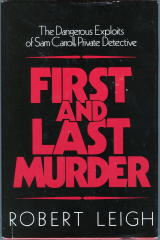
The blurb on the DJ flaps is an abridged version of the one above, with the last paragraph replaced by:
In the tradition of Raymond Chandler and Dashiell Hammett, Robert Leigh writes with the vividness and precision of a worldly poet, demonstrating that he is a new detective novelist of extraordinary promise.
[There is no indication of the book’s previous title. As I’m sure you’ll agree, the cover is hardly designed to catch a would-be buyer’s eye. The book was published back in the day when 90% of the hardcover mysteries produced were sold directly to libraries.]
Sat 25 Aug 2007
The latest batch of covers Bill Pronzini and I have uploaded to Bill Deeck’s Murder at 3 Cents a Day website are those for three of the smallest publishers of lending library mysteries.
These three are: Alliance Press (one mystery, 1935); Alliance Book Corporation (four mysteries, 1941-1942); and Jonathan Swift Publishers (also four mysteries, 1941-1942).
The books they published were intended almost solely for the lending library market, and copies with dust jackets are quite scarce today. Of the nine mysteries these three companies published between them, we’re pleased to be able to show you six of them. Of these, perhaps the most noteworthy is Hell on Friday by William Bogart, and unless you’re a long-time collector of the detective pulps, maybe not even he’s an author you’ll recognize. The rest are even less known, but in my opinion, at least, the covers still worth a peek.
Thu 23 Aug 2007
Best-selling spy novelist John Gardner passed away on 3 August 2007.
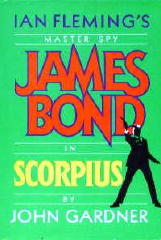
Best-known as the most prolific of the writers contracted to continue the adventures of James Bond after the death of Ian Fleming, Gardner, a former Anglican clergyman and recovering alcoholic, would eventually write 16 Bond novels, more than Fleming wrote himself, between 1981 and 1996.
Ironically, Gardner broke into spy fiction with a series about Boysie Oakes, a cowardly, selfish, and not particularly patriotic character who’s dragooned into spy work pretty much against his will. Oakes was created to be more or less the antithesis of Bond, yet the Oakes novels were an integral part of the resume that got Gardner the Bond gig.
Though his Bond novels are probably his best-known and most popular work, his reputation as a top-flight cloak-and-dagger writer would be secure if he’d never written a single word about 007. Two series in particular stand as his best work in the sub-genre.
His five novels featuring Herbie Kruger, a naturalized Brit of German birth who, after emigrating, has become the top agent of MI-6, are among the best series of British spy novels in the post-Le Carre era. Kruger debuted in The Nostradamus Traitor. The penultimate novel in the Kruger series, Maestro, was reportedly Gardner’s personal favorite of all his books.
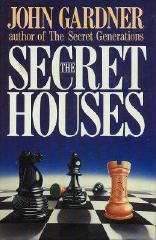
Kruger also makes a few cameo appearances in Gardner’s “Secret” trilogy, featuring the British Railtons and the American Farthings, two families, related by marriage, who defend freedom by choosing careers in their respective countries’ intelligence services. The trilogy effectively combined the multi-generational family saga, historical fiction, and espionage in an ambitious project that attempted, largely successfully, to show the history of espionage from just before World War I to the early 60s. The three books in the trilogy are The Secret Generations, The Secret Houses, and The Secret Families.
Most identified with spy fiction, Gardner was a versatile writer who could easily slip into other mystery sub-genres. A pair of carefully researched novels set in the world of Sherlock Holmes, for example, were told from the point of view of Professor Moriarty, depicting the iconic villain less as the effete “criminal mastermind” Conan Doyle portrayed than as a Victorian version of Al Capone or Don Corleone. Originally planned as a trilogy, the third novel has never appeared.
Two police procedurals, A Complete State of Death and The Corner Men, featured Scotland Yard detective Roger Torrey. The first, with the setting changed from London to New York, became the Charles Bronson film The Stone Killer.
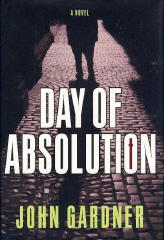
Between 1995 and 2001, Gardner abruptly stopped writing while he simultaneously fought cancer and the grief caused by his wife’s death. Winning his battle with the disease and coming to terms with the death of his spouse, he returned to writing with a vengeance, turning out a top-notch international thriller, Day of Absolution, and starting a new historical police procedural series about Suzie Mountford, a London Metropolitan policewoman fighting crime, and sexism,in the early years of World War II. The latest Mountford novel, No Human Enemy, will appear in bookstores later this month. Reportedly, the long-awaited third novel in the Moriarty trilogy is also being readied for publication.
He’ll be missed.
THE BOOKS. Adapted from Crime Fiction IV, by Allen J. Hubin.
GARDNER, JOHN (Edmund) (1926-2007 ) British editions only, unless US titles differ.
* The Liquidator (n.) Muller 1964 [Boysie Oakes]
* Understrike (n.) Muller 1965 [Boysie Oakes]
* Amber Nine (n.) Muller 1966 [Boysie Oakes]
* Madrigal (n.) Muller 1967 [Boysie Oakes]
* Hideaway. Corgi 1968. Story collection.
* A Complete State of Death (n.) Cape 1969 [Derek Torry]
* Founder Member (n.) Muller 1969 [Boysie Oakes]
* The Airline Pirates (n.) Hodder 1970 [Boysie Oakes]
* -The Censor (n.) NEL 1970
* Traitor’s Exit (n.) Muller 1970 [Boysie Oakes]
* Air Apparent (n.) Putnam 1971; See: The Airline Pirates (Hodder 1970).
* The Stone Killer (n.) Award 1973; See: A Complete State of Death (Cape 1969).
* The Assassination File (co) Corgi 1974
* The Corner Men (n.) Joseph 1974 [Derek Torry]
* The Return of Moriarty (n.) Weidenfeld 1974 [Prof. James Moriarty]
* A Killer for a Song (n.) Hodder 1975 [Boysie Oakes]
* The Revenge of Moriarty (n.) Weidenfeld 1975 [Prof. James Moriarty]
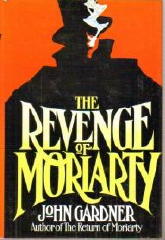
* To Run a Little Faster (n.) Joseph 1976
* The Werewolf Trace (n.) Hodder 1977
* The Dancing Dodo (n.) Hodder 1978
* The Nostradamus Traitor (n.) Hodder 1979 [Herbie Kruger]
* The Garden of Weapons (n.) Hodder 1980 [Herbie Kruger]
* Golgotha (n.) Allen 1980 [England; 1990]
* The Last Trump (n.) McGraw 1980; See: Golgotha (Allen 1980).
* License Renewed (n.) Cape 1981 [James Bond]
* For Special Services (n.) Cape 1982 [James Bond]
* The Quiet Dogs (n.) Hodder 1982 [Herbie Kruger]
* Flamingo (n.) Hodder 1983
* Icebreaker (n.) Cape 1983 [James Bond]
* Role of Honour (n.) Cape 1984 [James Bond]
* The Secret Generations (n.) Heinemann 1985 [Railton family; Farthing family]
* Nobody Lives Forever (n.) Cape 1986 [James Bond]
* No Deals, Mr. Bond (n.) Cape 1987 [James Bond]
* Scorpius (n.) Hodder 1988 [James Bond]
* The Secret Houses (n.) Bantam 1988 [Railton family; Farthing family; Herbie Kruger]
* License to Kill (n.) Coronet 1989 [James Bond]
* The Secret Families (n.) Bantam 1989 [Railton family; Farthing family; Herbie Kruger]
* Win, Lose or Die (n.) Hodder 1989 [James Bond]
* Brokenclaw (n.) Hodder 1990 [James Bond]
* The Man from Barbarossa (n.) Hodder 1991 [James Bond]
* Death Is Forever (n.) Hodder 1992 [James Bond]
* Maestro (n.) Bantam 1993 [Herbie Kruger]
* Never Send Flowers (n.) Hodder 1993 [James Bond]
* Seafire (n.) Hodder 1994 [James Bond]
* Confessor (n.) Bantam-UK 1995 [Herbie Kruger]
* Goldeneye (n.) Coronet 1995 [James Bond]
* Cold Fall (n.) Hodder 1996 [James Bond]
* Day of Absolution (n.) Scribner-US 2000
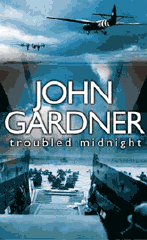
Detective Sergeant Suzie Mountford novels —
* Bottled Spider (2002)
* The Streets of Town (2003)
* Angels Dining at the Ritz (2004)
* Troubled Midnight (2005)
* No Human Enemy (2007)
For more on John Gardner’s life, as he told it himself, go to
http://www.john-gardner.com/past.html
Tue 21 Aug 2007
From this morning’s online www.booktrade.info:
MAGDALEN NABB

Posted at 8:56AM Tuesday 21 Aug 2007:
William Heinemann and Diogenes Verlag AG report that Magdalen Nabb sadly died suddenly at the weekend. Her funeral was held on Monday in Florence. […]
Her novels which featured Florentine investigator Marshal Guarnaccia include Death of an Englishman, Property of Blood, and most recently, Some Bitter Taste and The Innocent.
William Heinemann intend to publish her last novel, Vita Nuova, in 2008, with an Arrow paperback scheduled for 2009.
BIOGRAPHY: [Taken from her website]
Magdalen Nabb was born in Church, a moorland village in Lancashire, England. She studied art and, later, pottery which she taught in an English art school whilst exhibiting her own work until 1975 when she moved to Florence in Italy. There, she continued to work on pottery in a majolica studio in Montelupo Fiorentino, a pottery town near Florence, and began writing. It was in Montelupo that she met the model for Marshal Guarnaccia. The town itself, with its tumbledown factories and its wonderful restaurant, are featured in The Marshal and the Murderer. She still lives and writes in Florence, near enough to the carabinieri station in the Pitti Palace to stroll there regularly and have a chat with the marshal who keeps her up to date on crime in the city. […]
Having been a fan of Georges Simenon’s novels for as long as she can remember, she was astonished and overjoyed when Simenon wrote to congratulate her on her first novel. Their correspondence continued until his death and, until then, the first copy of each book went to him. His presence is very much missed but in difficult moments she can still get advice from him by browsing through his books and his letters.
SIMENON’S PREFACE TO DEATH IN SPRINGTIME:
“Dear friend and fellow author,
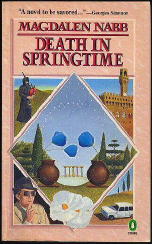
“What a pleasure it is to wander with you through the streets of Florence, with their carabinieri, working people, trattorie, even their noisy tourists. It is all so alive: its sounds audible, its smells as perceptible as the light morning mist above the Arno’s swift current; and then up into the foothills, where the Sardinian shepherds, their traditions and the almost unchanged rhythm of their lifestyle, are just as skilfully portrayed. What wouldn’t one give to taste one of their ricotta cheeses!
“You have managed to absorb it all and to depict it vividly, whether it is the various ranks of the carabinieri, and of course the ineffable Substitute Prosecutor, or the trattorie in the early morning hours. There is never a false note. You even capture that shimmer in the air which is so peculiar to this city and to the still untamed countryside close at hand.
“This is a novel to be savoured, even more than its two predecessors. It is the first time I have seen the theme of kidnapping treated so simply and so plausibly. Although the cast of characters is large, they are so well etched in a few words that their comings and goings are easily followed.
“Bravissimo! You have more than fulfilled your promise.”
Georges Simenon
Lausanne, April 1983
THE BOOKS: [Expanded from Crime Fiction IV, by Allen J. Hubin.]
NABB, MAGDALEN (1947-2007) Series character: Marshal Salvatore Guarnaccia (MG).
* Death of an Englishman (n.) Collins 1981; Scribner 1982. MG
* Death of a Dutchman (n.) Collins 1982; Scribner, 1983. MG
* Death in Springtime (n.) Collins 1983; Scribner, 1984. MG
* Death in Autumn (n.) Collins 1985; Scribner 1985. MG
* The Prosecutor [with Paolo Vagheggi] (n.) Collins 1986; St. Martin’s, 1988.
* The Marshal and the Murderer (n.) Collins 1987; Scribner 1988. MG
* The Marshal and the Madwoman (n.) Collins 1988; Scribner 1988. MG
* The Marshal’s Own Case (n.) Collins 1990; Scribner 1990. MG
* The Marshal Makes His Report (n.) Collins 1991; Harper 1992. MG
* The Marshal at the Villa Torrini (n.) Collins 1993; Harper 1994. MG
* The Monster of Florence (n.) Collins 1996; no US edition. MG
The following novels are not included in CFIV, having been published after the book’s end date of the year 2000. The bibliographic data for these may be incomplete or in error.
* Property of Blood. Heinemann; Soho Press, 2001. MG
* Some Bitter Taste. Heinemann 2003; Soho Press, 2003. MG
* The Innocent. Heinemann 2005; Soho Press, 2005. MG
* Vita Nuova. Heinemann 2008 MG?
Next Page »

